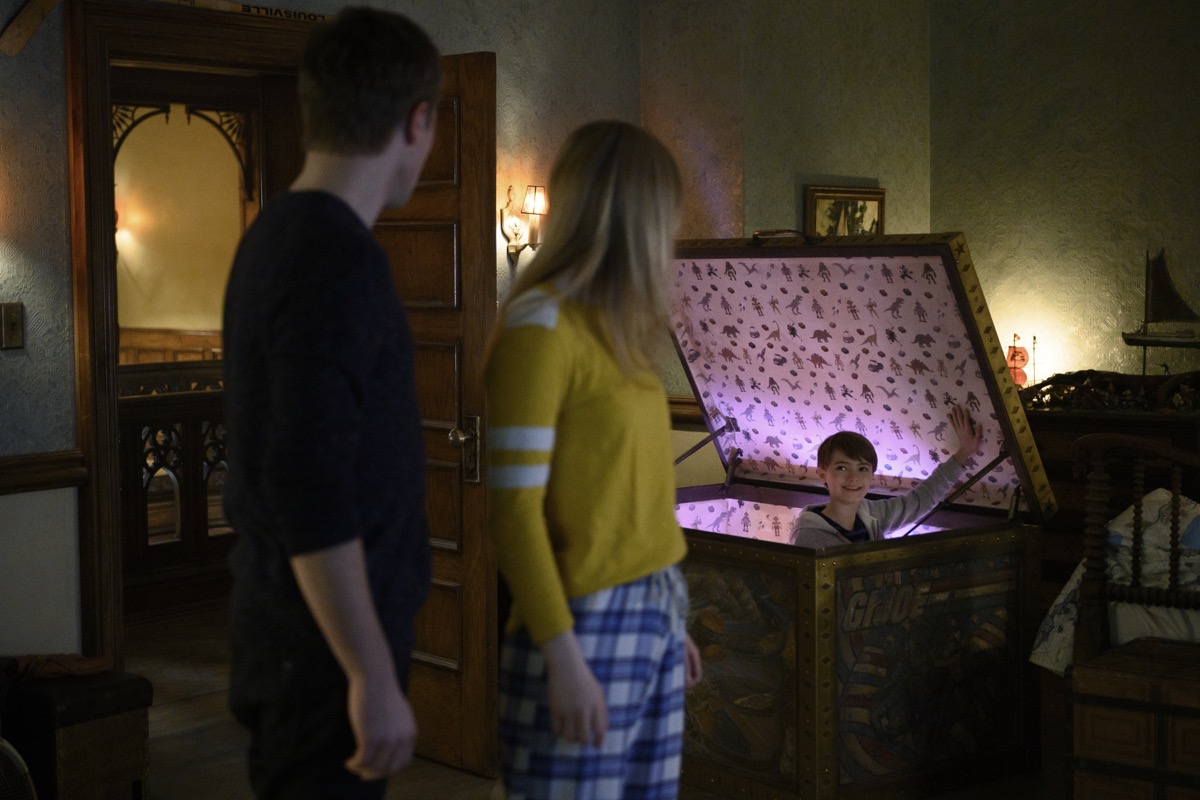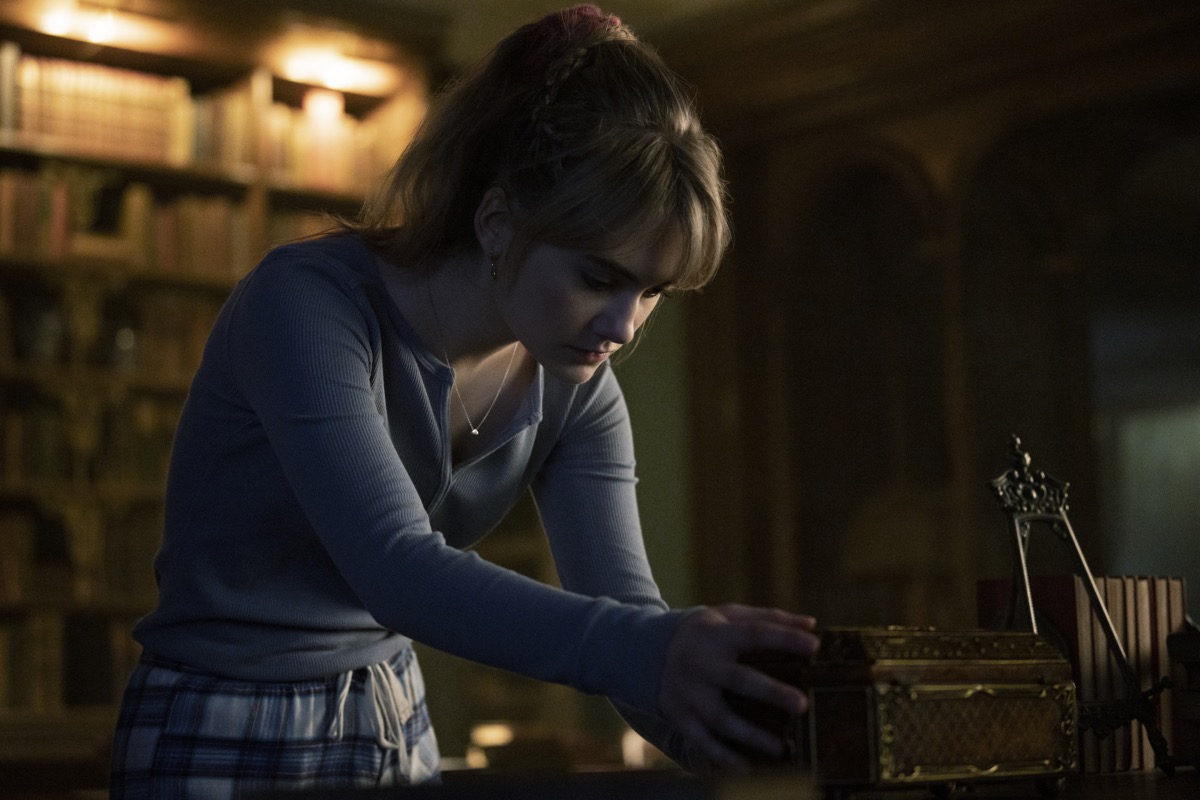**This article contains spoilers for the entire first season of Locke & Key on Netflix.**
Netflix’s Locke & Key begins after patriarch Rendell Locke is murdered, with the Locke family returning to Keyhouse, their mysterious ancestral family home in Matheson, Massachusetts. There, the three Locke kids—Tyler, Kinsey, and Bode—discover a series of magical keys that give the holder the ability to access specific magical powers, depending on which key they wield.
The Death key allows the user to walk through a particular door in Keyhouse and become a spectral version of themselves, seemingly dividing one’s soul from one’s body (and leaving the body lying on the floor). The Mirror key opens a door to the realm within mirrors, a sinister pocket dimension populated by malignant doppelgängers that can be used to imprison one’s enemies.
But perhaps the most interesting of them all is the Head key, which presents us with a physical manifestation of Kinsey’s interiority, allowing for a more in-depth exploration of the trauma she experiences in the wake of the death of her father.
The Head Key
When inserted into the back of the neck, the Head key grants access to a person’s mind through an entrance that magically appears with the turn of the key. The person whose mind is being accessed is also “duplicated,” allowing them to literally get inside their own head.
The “door to the mind” manifests differently depending on the person. For Bode, the first person we see using the Head key, it appears as a floating toy box which one climbs into in order to access the young boy’s mind. The door to Tyler’s mind appears to be the front door to the Locke family home in Seattle, where they lived before moving to Matheson.
What one finds within the door varies depending on the individual. Bode’s mind appears as an arcade, with projections of Spyro the Dragon on the walls and lots of noisy, frenetic activity. The arcade embodies a manifestation of Bode’s personality, filled with the bright flashing lights and high-energy you’d expect to find inside the youngest Locke child’s head.
Erin Voss, a high school friend of Rendell’s who was trapped inside her own brain using the Head key, has a mind that appears as the Keyhouse basement room where Rendell, Erin, and the rest of their friends (the previous Keepers of the Keys) spent their free time.
When Dodge, our villain, sees the entrance to Erin’s mind, which appears as the door to her alma mater, she remarks, “Way to peak in high school.” It’s a literal manifestation of Erin’s mental state, since she’s been literally trapped in her own mind while the rest of the world passes her by. In this sense, the Head key provides a physical manifestation of Erin’s trauma: She is unable to move beyond her traumatic experience and is indefinitely imprisoned in the room where she and the other Keepers of the Keys had their idyllic adventures come to an abrupt end when Rendell killed the demon-possessed Luke.
Kinsey’s Head key misadventures provide their own insightful character study. When the Head key is turned in her neck, the rotating door of what appears to be a shopping mall appears, and that’s exactly what Kinsey finds inside her head: a vast, colorful, and meticulously laid-out mall, featuring a ceiling so high you can’t even make it out and some other impossible, Escher-esque architectural flourishes.
The attempt to inflict order upon a seemingly infinite and architecturally impossible “mall” is an illuminating glimpse into the world inside Kinsey’s mind. While the space inside her head is “impossible,” she nevertheless has imposed a sort of organization upon the chaos—when she first enters her head, she even consults the kiosk map to see where everything inside her mind is located. This imposition of control upon her mind is a far cry from the chaos within Bode’s head and an indication of how she deals with things.
Fear Itself
When one uses the Head key to get inside someone’s head, they don’t just find architecture; they find manifestations of the person’s thoughts, memories, and emotions. The access to memories is part of what makes the Head key such an invaluable tool for Dodge: not only can she use it to view other people’s private memories in order to gather information, but she can also use it to outright remove memories, forcing the person whose memory has been stolen to forget.
Kinsey does use the Head key to access her memories, which manifest as brightly colored jars in a candy shop. She even shares some happy memories with her classmate, Scot Kavanagh. However, it isn’t her memories that Kinsey removes in her ill-advised efforts to skip over dealing with her trauma; it’s one of her emotions: her fear.
When Kinsey discovers her fear within her head, it manifests as a kind of monstrous, nightmare version of herself. Unlike the diminutive form her fear took in the original comic by Joe Hill, Gabriel Rodriguez, and Jay Fotos, the onscreen version appears as a full-size humanoid, making it a physical threat to any person who comes into contact with it (even inside Kinsey’s head).
Considering what we learn about Kinsey before she enters her own mind with the Head key, it makes sense that her fear would be overwhelming. In the second episode of the season, Kinsey has a bad reaction while filming The Splattering, the blood-spattered horror movie being made by the Savini Squad, her friends at Matheson Academy.
What Kinsey does with her fear is directly informed by her experiences. She’s frustrated with herself for becoming paralyzed during the filming of The Spattering. While it’s a reasonable reaction caused by the trauma of having to hide silently from the killer while her father was murdered, Kinsey is not satisfied.
Sick of being paralyzed by her fear, Kinsey uses the Head key to remove and incapacitate her fear, burying it in what essentially amounts to a grave in the woods at the end of episode three.
While only fiction can grant the ability to literally remove one’s fear, that’s not far off from the response some people have to traumatic experiences: When you experience something particularly horrible, it can be tempting to simply bury the feelings associated with it. Unfortunately, when something like that is buried, it has unintended repercussions, and it’s unlikely to remain underground—in reality or fiction.
The Girl Without Fear
At the beginning of episode four, Kinsey’s lack of fear affords her a sense of empowerment. In a montage set to upbeat pop music, she gets ready for school, even making breakfast for her family. While burying her fear may not have been the “healthy” way to deal with the situation, it nevertheless delivers the desired result—at least, at first.
Over the course of the next few episodes, Kinsey is seen embracing the “new” her—she feels extremely empowered to no longer be hampered by her fear, and has no problem speaking her mind to anyone with whom she disagrees, including pushing back against bullies.
However, a healthy amount of fear can be a motivator to avoid certain dangerous situations, as when Kinsey brings her friends to the sea caves to film their movie. When the tide unexpectedly comes in, the members of the Savini Squad nearly drown.
This is an eventuality that Kinsey probably should have been cautious of, especially since she had heard the story of several kids drowning in the caves. However, without her fear to make her question the decision, she isn’t concerned about the possible outcome, which results in her putting her closest friends in harm’s way.
Head Games
What Kinsey mistakes for emotional strength actually just creates a new vulnerability, which leaves her open to Dodge’s manipulation. Thanks to the fact that she was hidden nearby when Kinsey buried her fear at the end of the third episode of the season, Dodge knows that Kinsey has removed her fear from her head, and naturally exploits this information for her own ends.
Dodge uses the knowledge that she has removed her fear to manipulate Kinsey into allowing the Music Box key to be used to publicly humiliate Matheson Academy bully Eden Hawkins. This is yet another example of Kinsey’s lack of fear informing her behavior: she isn’t afraid of the consequences that might come from magically forcing Eden to make a fool of herself in the lunchroom of Matheson Academy.
Dodge (disguised as Gage) uses this lack of fear to manipulate Kinsey into treating Eden in a truly horrifying fashion. Even when Scot implores Kinsey to stop using the Music Box key on Eden, she and Gage continue, unafraid of the potential consequences.
Kinsey’s Fear at Large
Burying one’s fear might seem like a solution to the problem, but that which is buried will eventually return to the surface. This axiom is true when it comes to reactions to trauma. One may be able to bury the reaction within one’s mind for a certain period of time, but it isn’t gone; it will eventually return to light, possibly in unanticipated ways, or at an unexpected or inappropriate time.
In that same vein, the manifestation of Kinsey’s fear won’t stay buried, either. In episode eight, “Ray of F**cking Sunshine,” her fear returns to menace and attacks Eden. Removing her fear and burying it in the woods, rather than overcoming the emotion, has turned it into something even more monstrous. The fact that it attacks her bully, whom Kinsey admits she fears, demonstrates that while Kinsey’s fear may have been given a more corporeal form, it still functions in a way similar to a less fantastic embodiment of buried emotion. While one may believe their fear is contained, bottling it up leaves it ready to leap out to “attack” those toward whom one has strong suppressed emotions.
At the end of the first season, Kinsey’s fear is still at large, having fled into the Matheson woods after being fended off from its attack on Eden in episode eight. Will she eventually reinsert her fear into her head using the Head key? And if so, what could motivate her to do so? Hopefully, future seasons of Locke & Key on Netflix will unlock the answers to these questions as well as the other mysteries we are left with at the conclusion of the irresistible first season.
(featured image: Christos Kalohoridis/Netflix)
Want more stories like this? Become a subscriber and support the site!
—The Mary Sue has a strict comment policy that forbids, but is not limited to, personal insults toward anyone, hate speech, and trolling.—












Published: Mar 13, 2020 10:42 am